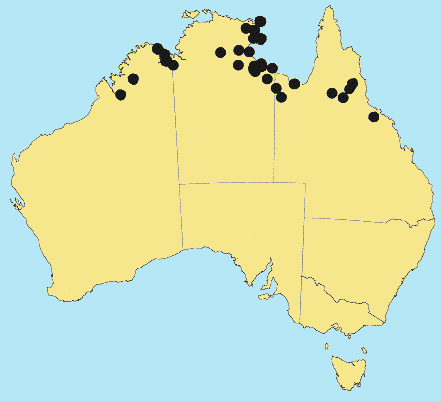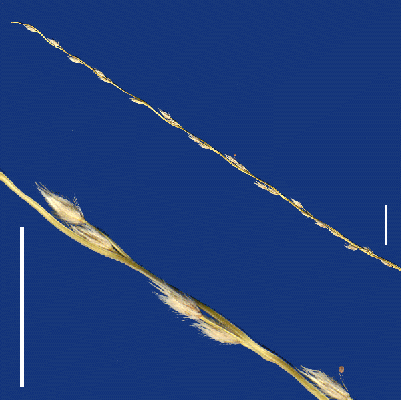Digitaria papposa (R.Br.) Beauv. Ess. Agrost. 51, 160, 170 (1812).
Classification. (GPWG 2001) : Subfamily Panicoideae. Paniceae.
Basionym and/or Replacement Name: Panicum papposum R. Br., Prodr. 192 (1810).
Type of Basionym or Protologue Information: HT: Brown 6120, Australia (K).
Key references (books and floras): [1810]. R.Brown, Prodromus (192 as Panicum papposum), [1878] G.Bentham, Flora Australiensis 7 (468 as Panicum papposum), [2002] D.Sharp & B.K.Simon, AusGrass, Grasses of Australia.
Habit. Perennial. Rhizomes present, elongated. Stolons absent. Culms erect, 40–70 cm tall, 6–11 -noded. Mid-culm internodes glabrous. Mid-culm nodes glabrous. Leaf-sheaths antrorsely scabrous, glabrous on surface. Leaf-sheath auricles absent. Ligule an eciliate membrane, 2–4.8 mm long, erose, acute. Leaf-blades flat, 9–27 cm long, 3–8 mm wide. Leaf-blade surface smooth or scabrous, glabrous or indumented.
Inflorescence. Inflorescence compound or subdigitate, a panicle of racemes. Racemes 10–20, spreading, 12–22 cm long, bearing 16–24 fertile spikelets on each. Central inflorescence axis 6–12 cm long.
Spikelets. Spikelets pedicelled, 1–4 in the cluster. Fertile spikelets 2-flowered, the lower floret barren (rarely male), the upper fertile, comprising 1 basal sterile florets, comprising 1 fertile floret(s), without rachilla extension, elliptic, dorsally compressed, 1.9–2.5 mm long. Rhachilla internodes elongated between glumes.
Glumes. Glumes thinner than fertile lemma. Lower glume oblong or ovate, membranous, 0 -nerved. Lower glume surface indumented. Upper glume elliptic, 1.4–2.5 mm long, membranous, without keels, 3–5 -nerved. Upper glume surface indumented. Florets. Basal sterile florets 1, barren, without significant palea. Lemma of lower sterile floret 100 % of length of spikelet, membranous, 7 -nerved.
Fertile lemma 1.7–2.3 mm long, without keel. Lemma apex mucronate. Lodicules present.
Continental Distribution: Australasia.
Australian Distribution: Western Australia, Northern Territory, Queensland.
Western Australia: Gardner. Northern Territory: Darwin & Gulf, Victoria River. Queensland: Burke, Cook, North Kennedy, Leichhardt.
Notes. Branching pattern of the primary branches of this species illustrates the transition between the typical form and the paniculate form of the subgenus Leptoloma. The hairy lower glume of D. papposa is a unique characteristic.
In tropical and subtropical sub-humid woodlands and coastal grasslands. Flowers Feb.-May-July.



